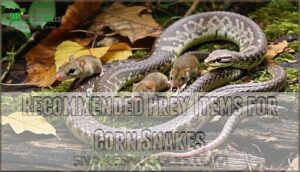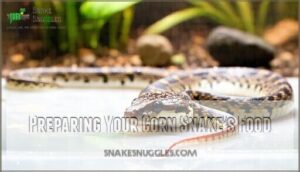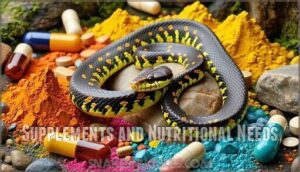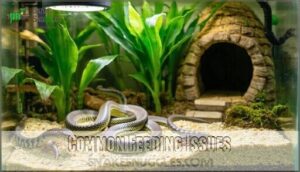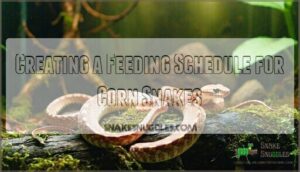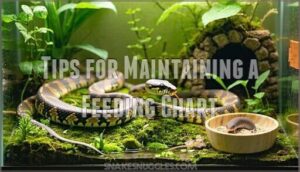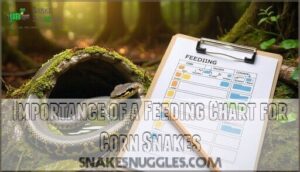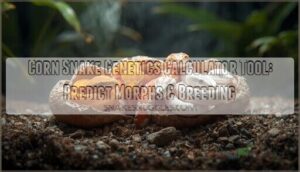This site is supported by our readers. We may earn a commission, at no cost to you, if you purchase through links.

Pick prey that’s 1-1.5 times the widest part of your snake, and always prep meals safely. After all, a corn snake with a good meal routine is as content as a cat in a sunbeam. There’s more to master for true peace of mind.
Table Of Contents
- Key Takeaways
- Corn Snake Feeding Schedule
- Choosing The Right Prey
- Preparing Your Corn Snake’s Food
- Feeding Frequency and Growth
- Supplements and Nutritional Needs
- Feeding Location and Water
- Common Feeding Issues
- Corn Snake Feeding Chart
- Advanced Feeding Techniques
- Frequently Asked Questions (FAQs)
- How often should you feed a corn snake?
- How do you feed a corn snake?
- How do you handle a corn snake?
- Can you feed a corn snake a carnivorous pet?
- How often should I feed a corn snake?
- How long can corn snakes go without eating?
- Can I feed my corn snake two mice at once?
- How do you know if a corn snake is starving?
- What is the best time of day to feed?
- How to handle picky eaters in corn snakes?
- Conclusion
Key Takeaways
- Adjust your corn snake’s feeding schedule to its age—hatchlings eat every 5–7 days, juveniles every 7–10 days, and adults every 10–14 days. – Offer prey that’s 1 to 1.5 times the widest part of your snake to support healthy growth and digestion. – Stick with frozen-thawed, properly sized rodents for safety and easier feeding, using tongs to mimic movement and reduce stress. – Track meals and growth on a feeding chart so you can spot appetite changes early and adjust care as needed.
Corn Snake Feeding Schedule
Getting your corn snake’s feeding schedule right is the key to a healthy, happy pet.
You’ll find out how often to feed your corn snake, what influences their appetite, and how their needs shift as they grow.
Frequency of Feeding Corn Snakes
Ever wondered how a corn snake’s appetite keeps pace with its age, growth, and the turning of the seasons? Hatchlings are busy bodies, needing meals every five to seven days. Juvenile schedules shift as they grow, but adults often settle into longer intervals—sometimes waiting two or even three weeks between feedings.
As corn snakes mature, their feeding frequency slows to match their metabolism. Senior needs can mean slightly more frequent snacks to keep up their strength. Seasonal changes, especially cooler months, might cause your snake to eat even less.
Building a reliable feeding schedule—one adapted to your snake’s age and activity—helps you avoid both overfeeding and underfeeding as you track their health.
How Often to Feed Corn Snakes
Figuring out how often to feed your corn snake is a bit like learning their rhythm—some weeks they’re hungry for more, other times they just want to take it slow. Your feeding schedule should match their age and growth.
Hatchlings thrive with meals every 5-7 days, juveniles do best on 7-10 day intervals, and adults appreciate longer feeding intervals of 10-14 days.
- Hatchlings: Every 5-7 days
- Juveniles: Every 7-10 days
- Adults: Every 10-14 days
Watch for individual variation and seasonal adjustments, and monitor growth so you can tweak feeding frequency as needed to foster a healthy, active snake.
Factors Affecting Feeding Schedules
Although creating a feeding schedule might look straightforward, several factors can pull the strings behind the scenes. Temperature influence is a silent driver—if the enclosure dips too cool, your corn snake’s appetite may follow. Seasonal changes often slow down feeding frequency, especially as winter rolls in.
Stress impact from frequent handling or a noisy room can shut down meal interest altogether. Prey presentation matters, too. Health conditions will always override plans, whether you’re feeding adults, hatchlings, or juveniles.
Maintaining the correct temperature gradients is essential for encouraging feeding.
Age and Size-Based Feeding Schedules
As your corn snake grows, its feeding routine should grow with it. Keeping up with their needs from hatchling days to adulthood helps your pet stay healthy every step of the way.
- Hatchling feeding must be frequent to foster rapid growth.
- Juvenile diets require careful size increases.
- Adult portions should stay consistent, but watch for weight changes.
- Senior adjustments mean monitoring appetite and responding as needed.
Feeding Schedules for Hatchlings, Juveniles, and Adults
Growth moves fast for young snakes and slows down with age, so their feeding routine needs to change right along with them. Hatchling Feeding means offering a meal every 5–7 days. Juvenile Schedules shift to every 7–10 days. Adult Portions get spaced out—feed every 14–21 days.
Watch frequency changes, and adjust during stress, shed, or senior years.
Choosing The Right Prey
Choosing the right prey is key to your corn snake’s health and growth. You’ll need to think about prey size, type, and variety to match your snake’s needs.
Prey Size and Type for Corn Snakes
Once you’ve settled on a feeding schedule, it’s time to pick out the right prey to match your corn snake’s size and appetite. Prey size matters—a pinky mouse for hatchlings, fuzzy mouse for growing juveniles, and an adult mouse as your corn snake matures. Aim for food 1 to 1.5 times the width of your snake’s thickest point.
Mixing rodent types boosts nutritional value and helps avoid boredom. Always check that the prey is appropriately sized; oversized meals can stress digestion. If you’re sourcing prey, inspect them for health and cleanliness. Think of it like creating a balanced menu:
- Tiny pinky mice for hatchlings
- Fuzzy mouse or rat pups for juveniles
- A healthy adult mouse for mature snakes
Frozen Vs Live Prey for Corn Snakes
When weighing the choice between frozen prey and live prey for your corn snake, frozen food comes out ahead for both safety and ethics. Thawing frozen prey cuts injury risks, limits health hazards, and encourages ethical sourcing in your care routine. Considering the snake’s well-being, frozen rodents offer a safer feeding alternative for snake owners.
- Nutrient comparison between frozen prey and live mice is nearly identical. – Handling frozen eliminates bites and stress. – Higher acceptance rates ease regular feeding.
Recommended Prey Items for Corn Snakes
Wondering what’s on the menu for your hungry snake? Your best picks are frozen-thawed rodent types—like pinky mouse, juvenile mice, or adult mouse—sized to match your snake’s thickest part.
These prey items offer strong nutritional value and safety with proper prey preparation.
For ethical sourcing, skip wild-caught animals, and always handle prey selection carefully to protect your snake.
Prey Variety and Rotation for Corn Snakes
Feeding your corn snake a mix of different prey now and then keeps things interesting for your pet and helps promote its health. Nutritional diversity and prey rotation benefits go hand in hand—think of it as expanding the menu at home.
Just rotating prey items prevents pickiness and exposes your snake to a range of nutrients. For example, you might consider these feeder options:
- Mice or rats (stick with captive-bred prey for safety).
- The occasional day-old chick.
- Insects for novel prey options.
- Scenting techniques to encourage new prey acceptance.
This approach keeps their rodent diet balanced and engaging.
Preparing Your Corn Snake’s Food
Preparing your corn snake’s food means thawing, warming, and handling frozen prey in a way that keeps your snake healthy and interested in eating. Get the basics right, and feeding time will go smoothly for both you and your snake.
Thawing Frozen Prey for Corn Snakes
Getting frozen prey ready the right way can make all the difference for your snake’s next meal. For safe thawing, skip the microwave—hot spots risk damaging nutrients and raising bacterial risks. Instead, thaw frozen prey in a sealed bag under cool running water or overnight in the fridge.
Never refreeze thawed rodents; this change impacts both nutritional value and safety.
Warming Prey for Corn Snakes
Before you offer your corn snake a meal, give those thawed rodents a gentle warm-up so dinner feels just right. To guarantee peak temperature and promote digestive health, rely on these warming methods:
- Submerge sealed prey in warm water—never too hot.
- Confirm with a thermometer.
- Skip microwaves for safety concerns.
- Even warmth means better palatability factors.
Handling and Presenting Prey to Corn Snakes
Ever tried playing chef for a picky eater who slithers instead of talks? Presenting corn snake food is all about safe handling—skip fingers, use feeding tongs. Mimic prey movement by gently wiggling the frozenthawed mouse, catching your snake’s interest. This avoids bites but fits their natural feeding process.
| Prey Presentation | Tongs vs. Fingers | Safe Handling |
|---|---|---|
| Mimic movement | Reduces bite risk | Protects you |
| Match prey size | Improves accuracy | Calmer snake |
| Warm prey | Greater precision | Less stress |
| Offer, don’t toss | No scent confusion | Clean feeding |
| Consistent method | Natural behavior | Reliable feed |
Tips for Feeding Corn Snakes
Think of feeding time as the main act in your corn snake’s weekly routine—get the details right, and your snake will thrive. For safe handling and enthusiastic eating, try these:
- Choose prey that matches your snake’s size. – Always mimic movement with tongs. – Stick to your feeding schedule and frequency. – Offer a quiet environment and proper hydration. – Mix up prey types—variety matters.
Feeding Frequency and Growth
How often you feed your corn snake has a big impact on how quickly it grows and stays healthy. Knowing when to adjust feeding schedules helps you spot problems early and foster steady, safe growth.
How Feeding Frequency Affects Growth
How often you feed your corn snake sets the pace for its growth rate. Give hatchlings and juveniles meals more frequently to fuel healthy development, but slow things down for adults to avoid obesity risks.
Adaptive schedules, tuned to their age and body weight, keep them thriving—helping your corn snake weave the line between vigorous growth and lasting health.
Adjusting Feeding Schedules for Growth
When you see your corn snake growing faster or slowing down, it’s a clear sign it’s time to take another look at the feeding schedule. Growth rate isn’t just a number—it tells you when to tweak prey size or shift the feeding frequency. Hatchlings, juveniles, and adults all have different metabolic needs.
You’ll want to factor in:
- Recent shedding impact
- Seasonal variations in appetite
- Need for prey adjustments as they age
- Energy demands during growth spurts
- Maintaining a flexible, responsive feeding schedule
Stay observant—your corn snake’s cues matter.
Monitoring Weight and Adjusting Feeding Schedules
Keeping tabs on your corn snake’s weight is like glancing at a dashboard—you’ll spot changes early, so you can tweak their meals before small issues turn into big ones.
Here’s a practical routine:
- Weigh monthly to catch weight fluctuation causes.
- Score body condition, not just number on the scale.
- Use seasonal adjustments for individual variation and growth rate tracking.
Factors Affecting Growth and Feeding Schedules
Juggling temperature, space, and stress is the secret behind steady growth and a healthy feeding rhythm for your corn snake. A warmer environment speeds up their metabolic rate, making hatchlings and juveniles hungry more often than adults. If your snake is highly active—or genetically inclined toward rapid growth—you’ll need to tweak the feeding schedule. Every corn snake is unique, so pay close attention to individual variation and fine-tune your approach using cues from their behavior.
| Factor | Impact on Feeding Schedule |
|---|---|
| Environmental Temperature | Adjusts meal frequency |
| Activity Level | Alters appetite |
| Genetic Factors | Drives growth rate |
| Individual Variation | Requires customization |
| Age Group | Sets baseline schedule |
Supplements and Nutritional Needs
Supplements and proper nutrition keep your corn snake healthy and active. Understanding their needs helps you offer a balanced diet without unnecessary extras.
Calcium and Multivitamin Supplements for Corn Snakes
Getting the right blend of calcium and vitamins into your corn snake’s diet is like giving your scaly friend the keys to a longer, healthier life. Weekly nutritional supplementation promotes strong bones and prevents nutrient deficiencies, but keep an eye out—too much can do harm.
For balanced reptile nutrition, remember:
- Mix calcium and multivitamin supplement 50/50
- Adjust dosage guidelines for age or breeding
- Watch for over-supplementation risks and deficiency symptoms
Recommended Supplements for Corn Snakes
A handful of the right supplements can make all the difference in keeping your corn snake healthy for the long haul. Supplement necessity isn’t just a buzzword—it’s about dodging nutrient deficiencies.
Blend a calcium source with Vitamin D3 into a multivitamin supplement and dust prey every few feedings.
Reliable brands like Repashy or Arcadia guarantee your snake’s D3, calcium, and hydration needs never get overlooked.
Nutritional Needs of Corn Snakes
Nutrition forms the backbone of a strong corn snake diet and feeding schedule. It’s not just about prey size—your corn snake needs essential minerals, hydration methods, and regular meal variety to thrive. Corn snake nutritional needs go beyond feeding frequency or prey variety; they hinge on details like Vitamin D, mineral balance, and gut health.
So, what should you really focus on?
- Rotate between mice, young quail, and other prey.
- Assure calcium and occasional vitamin D* supplementation.
- Offer fresh water for hydration.
- Select prey that promotes gut health and mineral balance.
Providing a Balanced Diet for Corn Snakes
Now that you know what your corn snake needs to stay healthy, let’s talk about how you can build a diet that actually gives them everything they need.
Aim for dietary variety by rotating prey—mice, young rats, even quail—using your feeding schedule or Corn Snake Feeding Chart.
Prioritize feed quality, proper prey size, and nutrient balance to foster long-term snake nutrition and smart meal planning.
Feeding Location and Water
Feeding your corn snake in the right place and providing fresh water help keep your pet healthy and stress-free.
Small details in setup and routine can make mealtimes safer and easier for both of you.
Feeding Corn Snakes in Their Enclosure
Once you’ve covered your corn snake’s diet, figuring out where to feed them can make all the difference in keeping things peaceful and trouble-free. Feeding inside the snake enclosure helps with environmental control and humidity management. Plus, it’s safer and easier on your corn snake’s nerves.
Here are three quick wins for smarter snake care:
- Limit unnecessary handling.
- Use feeding tools, never bare hands.
- Stick to your feeding schedule.
Providing Fresh Water for Corn Snakes
After feeding your corn snake in its enclosure, don’t forget that fresh water is just as important for their health and happiness. Choose a sturdy bowl wide enough for easy access—about the same width as your snake.
Refill with clean, room-temperature water daily to promote proper hydration, water quality, humidity levels, and overall snake health. Regular bowl cleaning prevents issues and keeps your corn snake thriving.
Tips for Maintaining a Clean and Hygienic Environment
Keeping your corn snake’s home spotless isn’t just about looks—it’s the secret to a healthy, stress-free life for your pet. Prioritize Enclosure Cleaning: spot-clean waste daily, swap out soiled substrate often, and scrub the water bowl weekly.
Good Hygiene Practices limit odor and bacteria, creating an inviting space that fosters Snake Health, Environmental Safety, and the best Corn snake care for your companion.
Reducing Stress While Feeding Corn Snakes
Just like a tidy space gives you peace of mind, feeding your corn snake in a calm, quiet spot helps your pet feel safe at mealtime. Choose a low-traffic area with minimal noise—this small step works wonders for stress reduction.
Avoid handling for two days after feeding, and offer a clean water bowl. A gentle approach and a steady feeding schedule help even reluctant feeders settle into healthy habits.
Common Feeding Issues
Feeding issues can sometimes crop up with even the healthiest corn snakes, leaving you scratching your head. Knowing the most common reasons behind food refusal or changes in appetite will help you find the right solution fast.
Reasons for Food Refusal in Corn Snakes
Why does your corn snake suddenly snub dinner? Environmental stress, husbandry issues, and even seasonal changes can all disrupt feeding habits. Sometimes, it’s as simple as prey size or snake diet not matching expectations. Keep an eye out for these three common triggers:
- Incorrect enclosure temperature.
- Recent relocation or frequent handling.
- Health problems or parasites affecting reluctant feeders.
Shed Cycle and Feeding Issues
Every snake keeper runs into a time when their pet just isn’t interested in a meal, and most of the time, it’s because shedding is right around the corner.
During the shedding process, feeding refusal is normal. It helps prevent skin issues and feeding stress.
Don’t worry—just adjust your feeding schedule and prey size, then resume regular feeding habits after the shed.
Seasonal Behavior Changes and Feeding
When the seasons change, you might notice your corn snake slowing down and turning its nose up at food. This is normal—seasonal hunger, brumation, and shifts in temperature, humidity, or daylight hours (photoperiod impact) can all mess with feeding cycles.
Adjust the feeding schedule and frequency as needed, but rest assured, your captive-bred prey will still be there when appetite returns.
Health Issues and Feeding Problems
Sometimes, after your snake’s routines settle down, you might spot food left behind or notice your corn snake isn’t quite acting like itself—and that’s when health issues can start to show up. Overfeeding risks, especially in adults, can lead to vomiting, digestive issues, and reduced energy. Underfeeding signs might include visible ribs or spine—big red flags for snake malnutrition. Feeding injuries from live prey or stress might cause your snake to refuse food for weeks.
If your corn snake is missing meals frequently, consider these points:
- Check for digestive problems or regurgitation
- Watch for changes in body condition
- Monitor for stuck shed or respiratory issues
Stay observant and proactive about Corn Snake Health and Care.
Corn Snake Feeding Chart
A feeding chart keeps your corn snake’s schedule clear and helps you avoid over- or underfeeding. Recording each meal lets you spot changes in growth or appetite early.
Creating a Feeding Schedule for Corn Snakes
If you want to keep mealtime easy for both you and your snake, a good schedule is your best friend. Think of feeding schedules as your guide for balanced snake nutrition. Offer appropriately sized prey at intervals based on age—hatchlings every week, adults every two.
Here’s a handy Feeding Schedule for Different Age Groups:
| Age | Feeding Frequency | Prey Size |
|---|---|---|
| Hatchling | 5–7 days | 1x body width |
| Juvenile | 7–10 days | 1–1.5x body width |
| Adult | 10–21 days | 1–1.5x body width |
Tracking Growth and Adjusting Feeding Schedules
Think your corn snake never changes? Keep a watchful eye on its size, and you’ll spot the subtle ways growth can shift its appetite from week to week. Growth monitoring means regularly checking your snake’s weight—and making nutrition planning part of your routine.
When your hatchling suddenly outgrows its current prey, that’s your cue to tweak the feeding schedule and prey size. Adults need less frequent meals, but if weight drops, bump up feeding frequency or adjust prey type.
Take a look at this quick chart for an at-a-glance guide on adjusting your snake’s meals:
| Age | Prey Size | Feeding Frequency |
|---|---|---|
| Hatchling | Pinky mouse | Every 5-7 days |
| Juvenile | Fuzzy mouse | Every 7-10 days |
| Adult | Adult mouse | Every 10-14 days |
Tips for Maintaining a Feeding Chart
Think of a feeding chart as your snake’s personal scrapbook—it captures each meal, every milestone, and even how you keep them hydrated. Jot down the date, the size of their prey, and what you’ve done for hydration.
Looking back over these notes helps you figure out just when to adjust meals or try something new with their routine.
| Date | Prey Size | Hydration Provided |
|---|---|---|
| Sept 10 | Small | Fresh Water |
| Sept 14 | Small | Mist |
| Sept 18 | Medium | Fresh Water |
| Sept 22 | Medium | Mist |
| Sept 26 | Medium | Fresh Water |
Importance of a Feeding Chart for Corn Snakes
Ever wish you’d a crystal ball for your snake’s health? Keeping a feeding chart is the next best thing. Tracking each feeding helps you tune your corn snake’s feeding schedule, nail the right prey size, and spot subtle changes in appetite or growth.
A chart turns meal planning from guesswork to science, letting you monitor feeding habits and guarantee proper snake nutrition.
| Feeding Date | Prey Size |
|---|---|
| 9/1 | Pinky mouse |
| 9/8 | Fuzzy mouse |
| 9/15 | Fuzzy mouse |
| 9/22 | Hopper mouse |
Advanced Feeding Techniques
Sophisticated feeding techniques can help you meet your corn snake’s special needs and encourage natural hunting behaviors.
Try these approaches to make feeding safer, more effective, and rewarding for both you and your snake.
Feeding Corn Snakes in The Dark
Curiosity comes alive at night for your snake, so offering a meal in the quiet dark can feel just right for both of you. Feeding corn snakes in low light appeals to their natural hunting instincts and fosters healthy feeding habits.
Try these tips for Dark Feeding success:
- Warm prey for ideal Feeding Cues and detection
- Use minimal light—Snake Vision loves the dark
- Mimic Nighttime Hunting with gentle movement
Using Different
Have you ever wondered what might spark a new appetite or inspire natural behaviors in your corn snake? Try mixing up Feeding Tools or switching Prey Types—sometimes juveniles and adults perk up for fresh options like quail or different supplement forms.
Use Enrichment Methods, such as hiding food or shifting feeding times, to tap into your snake’s natural curiosity.
Adjusting Water Sources and enclosure features also fosters a more active feeding schedule for hatchlings and older snakes alike.
Frequently Asked Questions (FAQs)
How often should you feed a corn snake?
Regular feeding frequency matters—a hatchling’s high metabolism calls for meals every 5-7 days; juveniles need food every 7-10 days; adults do best at 10-14 day intervals to suit their age and activity levels.
How do you feed a corn snake?
Curious how to keep feeding calm and safe? Thaw the prey entirely, warm it to body temp, use feeding tongs for safe handling, and gently wiggle to mimic hunting—offering variety and sticking to a steady feeding schedule.
- Thaw frozen prey overnight for even defrosting.
- Warm prey to about 100°F for realism.
- Use feeding tongs—never bare hands—for safe, clean prey presentation.
- Feed in a quiet space to reduce stress.
- Gently wiggle prey to mimic natural hunting and promote a healthy feeding process.
How do you handle a corn snake?
Ease your hands beneath your snake, offering steady assistance from head to tail.
Calm, gentle touch is key—avoid abrupt grabs or squeezing.
Never handle right after feeding or before a shed for safe, stress-free interaction.
Can you feed a corn snake a carnivorous pet?
Why tempt fate with an experiment that risks your pet’s health? Corn snakes aren’t built to handle carnivorous pets as food. Exotic Prey outside their usual diet can cause serious Feeding Risks for Pet Safety and Snake Nutrition:
- Carnivore Diets differ; corn snakes can’t digest fur, claws, or bones from other pets.
- Non-standard prey may lead to regurgitation and health problems.
- Improper prey size disrupts the feeding schedule and slows digestion.
- Safer choices: stick to small rodents—these fit natural feeding habits and snake diet requirements.
How often should I feed a corn snake?
“Measure twice, cut once.” That old saying rings true for meal frequency—feed hatchlings every 5-7 days, juveniles every 7-10, and adults every 10-14 days.
Adjust feeding intervals as needed for healthy growth rates.
How long can corn snakes go without eating?
Wondering about corn snake survival limits? Generally, hatchlings and adult corn snakes can withstand fasting periods of 2–3 months, but food deprivation outside standard eating intervals is risky. Frequent snake starvation often signals issues with feeding frequency or environment.
- Fasting Periods: 2–3 months max
- Risks: Starvation, weight loss
- Best Practice: Stick to regular feeding intervals
Can I feed my corn snake two mice at once?
Feeding your corn snake two mice in one sitting is possible, but watch for double feeding risks and multiple prey issues.
Always match prey size to your snake’s girth and avoid overfeeding, which can quickly cause health problems.
How do you know if a corn snake is starving?
How can you spot starvation signs in your corn snake? Watch for weight loss, restless prowling, pronounced ribs, and increased tongue-flicking.
Persistent hunger after meals or frantic feeding cues mean it’s time for a health check.
What is the best time of day to feed?
Regarding snake feeding, there’s no single best mealtime. Focus on consistent feeding windows that fit your daily routines.
Meal timing matters less than frequency and matching feeding practices to your corn snake’s natural circadian rhythms.
How to handle picky eaters in corn snakes?
Much like coaxing a fussy toddler to the dinner table, handling a picky corn snake eater means mixing up your Feeding Strategies—try changing prey type, adjusting prey warmth, or dimming the lights for real Appetite Stimulation.
- Switch prey species or color for variety
- Warm prey to mimic live movement
- Offer food at dusk for natural hunting rhythm
- Verify proper hydration—thirsty snakes often refuse meals
- Check for stress or health issues affecting appetite
Conclusion
Like a clock keeps time, a solid corn snake feeding schedule keeps your snake’s world steady. When you know what to feed, how often, and why, you set your corn snake up for a lifetime of health and comfort.
Pay attention to your snake’s appetite, growth, and habits—because every thriving corn snake is proof that routine matters. Use your knowledge to shape a feeding schedule that fits every stage and strengthens the bond you share.
- https://www.zenhabitats.com/blogs/reptile-care-sheets-resources/corn-snake-complete-food-guide
- https://exoticdirect.co.uk/news/feeding-corn-snakes/
- https://www.reddit.com/r/cornsnakes/comments/16934lq/is_this_feeding_chart_correct/
- https://raw-petfood.pl/en/blog/would-a-corn-snake-eat-a-hatchling-description-of-the-study-1705327645.html
- https://animal-pedia.org/snakes/corn-snakes/



